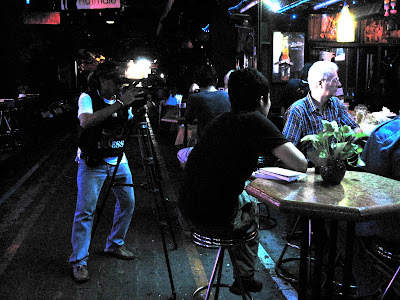
A few weeks ago I cut my trip to Burma short so I could get back to Bangkok and see the resolution of the Redshirt protests (which, as you know, turned out badly for all concerned). I arrived a few days before the curfew was implemented. The army had erected checkpoints on all the streets leading up to the protest areas, and the surrounding areas were eerily quiet. I told the taxi driver to take me to Patpong, (Bangkok's notorious red light district) figuring that it was A. adjacent to the protest areas and B. that nobody would question my motives for being there.

And this is Patpong, nearly deserted on a Friday night. As soon as I got out of the taxi I was mobbed by a crowd of desperate pimps. Bar? Drink? Massage? Hotel? 'Boom boom'? Pity the poor pimps, whose livelihood must have taken a serious hit during this period of unrest. A few bars were open, but the few sad old white dudes making up their clientele were vastly outnumbered by members of the press filming them, for news reports that you can probably write for yourself:
Deserted stations and deserted streets:
And that was it. The city was nervously holding its breath. And while it was clear that the government was going to take action to resolve the situation, it wasn't clear when that would be. The state of siege could have persisted for another week, and I didn't have a week to spare, so I went South to the islands. That's why when the army went in two days later, leaving 80 people dead, 2000 people injured, and the heart of Bangkok a smouldering ruin, I was here:

When I got back, things were almost entirely back to normal. The Redshirt rank-and-file had dispersed back to the countryside or into the mass of urban poor. The high-profile Redshirt leaders were under arrest or, in the case of Thaksin, sheltering from the Thai government's warrant for his arrest on terrorism charges in Montenegro, where he's a citizen. And the government seemed torn between the conflicting aims of promoting 'reconciliation' in the form of some kind of restorative justice process, and justifying the heavy-handedness of its response by demonising the Redshirts. The demonisation took two forms - portraying the protesters as terrorists, and insinuating that their true intention was to overthrow the monarchy. Dark comparisons were drawn with Nepal (where the monarchy was recently deposed), and with the storming of the Bastille. This is an especially serious charge in Thailand, with its archaic and punitive lèse majesté laws (I'm going to save my post on the monarchy for another day, perhaps when I'm no longer living in Thailand).


The city was being energetically cleaned, though evidence of the riots was still everywhere throughout the protest areas, like the melted bus shelter seats above and, of course, the smoking wreckage of the Central World mall. There are weird echoes of Fight Club in the targets that were chosen for destruction, all those shopping malls and boutiques and entertainment complexes and billboards. Was it just because they were convenient, or were they picked out as symbols of a consumer capitalism that has left so many in Thailand behind? Or a combination of the two? On the other side of the equation, the destruction of these landmarks elicited a suprising outpouring of grief. Something strikes me as odd about leaving flowers for a burnt-out mall where no-one actually died, while neglecting the numerous other symbolic sites available where people did actually die (the Rama VI statue in Lumphini, for example). It may be that the mall, by virtue of its high visibility and central location, became a convenient locus for a more general outpouring of grief. It may also be that by leaving flowers at the mall, Thais distance themselves from the Redshirts and proclaim their fealty to the established order. The op-eds that filled the Bangkok Post in the following weeks bewailing the loss of the mall and the theatre (but we'll always have the memories, etc) may have served the same purpose.

Random images of destruction - The corner of Lumphini Park where the main barricades were located. The only evidence that remains is the paving stones, ripped up to provide the protesters with ammunition.
A scorched palm:
A broken billboard:
The smoking remains of the venerable Siam Theatre:
Fortunately this poster advertising Gerard Butler and Jennifer Aniston in 'The Bounty Hunter' survived the blaze:
The government dotted the city centre with this cheerfully conciliatory ad campaign:
In the same spirit, the newspapers were full of stories of peppy, civic-minded teens taking to the streets to clean up the city. This zeal for putting things back in order and for empty rhetoric of conciliation (while simultaneously demonising everyone) virtually assures that the grievances which led to the whole mess will remain unaddressed. At least until the next coup or uprising.























 Woodlice aren't actually insects, but terrestrial crustaceans. Their ability to roll into a ball when disturbed has given the common name of 'pill bug'. I waited 10 minutes for this stubborn little bastard to unroll himself but he was so committed to his defensive strategy that I eventually gave up. Instead I found this, possibly the greatest Youtube clip ever. Play it with sound.
Woodlice aren't actually insects, but terrestrial crustaceans. Their ability to roll into a ball when disturbed has given the common name of 'pill bug'. I waited 10 minutes for this stubborn little bastard to unroll himself but he was so committed to his defensive strategy that I eventually gave up. Instead I found this, possibly the greatest Youtube clip ever. Play it with sound.





















